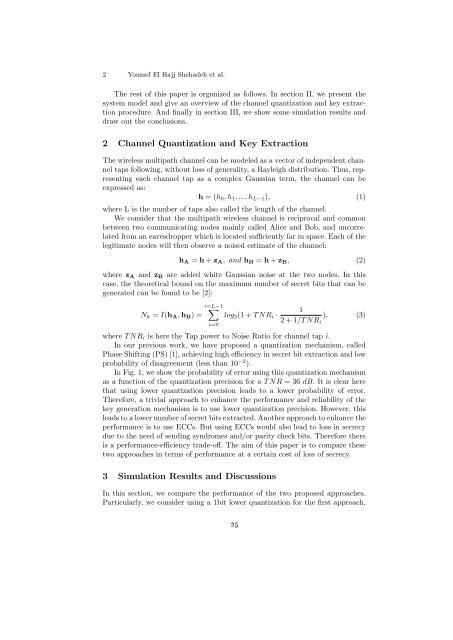MMB & DFT 2012 Workshop Proceedings
MMB & DFT 2012 Workshop Proceedings
MMB & DFT 2012 Workshop Proceedings
Create successful ePaper yourself
Turn your PDF publications into a flip-book with our unique Google optimized e-Paper software.
2 Youssef El Hajj Shehadeh et al.The rest of this paper is organized as follows. In section II, we present thesystem model and give an overview of the channel quantization and key extractionprocedure. And finally in section III, we show some simulation results anddraw out the conclusions.2 Channel Quantization and Key ExtractionThe wireless multipath channel can be modeled as a vector of independent channeltaps following, without loss of generality, a Rayleigh distribution. Thus, representingeach channel tap as a complex Gaussian term, the channel can beexpressed as:h = (h 0 , h 1 , ..., h L−1 ), (1)where L is the number of taps also called the length of the channel.We consider that the multipath wireless channel is reciprocal and commonbetween two communicating nodes mainly called Alice and Bob, and uncorrelatedfrom an eavesdropper which is located sufficiently far in space. Each of thelegitimate nodes will then observe a noised estimate of the channel:h A = h + z A , and h B = h + z B , (2)where z A and z B are added white Gaussian noise at the two nodes. In thiscase, the theoretical bound on the maximum number of secret bits that can begenerated can be found to be [2]:N k = I(h A , h B ) =i=L−1∑i=0log 2 (1 + T NR i ·12 + 1/T NR i), (3)where T NR i is here the Tap power to Noise Ratio for channel tap i.In our previous work, we have proposed a quantization mechanism, calledPhase Shifting (PS) [1], achieving high efficiency in secret bit extraction and lowprobability of disagreement (less than 10 −2 ).In Fig. 1, we show the probability of error using this quantization mechanismas a function of the quantization precision for a T NR = 36 dB. It is clear herethat using lower quantization precision leads to a lower probability of error.Therefore, a trivial approach to enhance the performance and reliability of thekey generation mechanism is to use lower quantization precision. However, thisleads to a lower number of secret bits extracted. Another approach to enhance theperformance is to use ECCs. But using ECCs would also lead to loss in secrecydue to the need of sending syndromes and/or parity check bits. Therefore thereis a performance-efficiency trade-off. The aim of this paper is to compare thesetwo approaches in terms of performance at a certain cost of loss of secrecy.3 Simulation Results and DiscussionsIn this section, we compare the performance of the two proposed approaches.Particularly, we consider using a 1bit lower quantization for the first approach,26


